Previous Year Questions: Probability Theory | Engineering Mathematics for Computer Science Engineering - Computer Science Engineering (CSE) PDF Download
Q1: When six unbiased dice are rolled simultaneously, the probability of getting all distinct numbers (i.e., 1, 2, 3, 4, 5, and 6) is (2024 SET-2)
(a) 1/324
(b) 5/324
(c) 7/324
(d) 11/324
Ans: (b)
Sol: We have 6 unbiased dices that are rolled simultaneously.
As, dices are unbiased. Then, P(x) = 1/6 where x ∈ {1, 2, 3, 4, 5, 6}.
When a dice is rolled then any number out of 6 can show up. So, with 1 dice we have 6 possible outcomes.
And, when we have 6 dices and each dices have 6 choices then total possible outcomes = 66.
Total cases : 66.
Now, we want different numbers on all 6 dices. So, combination like these are our feasible cases :
(1, 2, 3, 4, 5, 6), (1, 3, 5, 2, 4, 6), (2, 4, 6, 5, 3, 1) , (6, 1, 3, 5. 4, 2), - - - - - - - - - - , (6, 5, 4, 3, 2, 1)
How many such feasible case?
It will be 6! = 720
Feasible cases : 6! = 720
So, Required Probability : Feasible cases / Total Cases
= 6! / 66.
= 5 / 324.
Hence, Option B is correct Answer.
Q2: A bag contains 10 red balls and 15 blue balls. Two balls are drawn randomly without replacement. Given that the first ball drawn is red, the probability (rounded off to 3 decimal places) that both balls drawn are red is ____ (2024 SET-1)
(a) 0.214
(b) 0.325
(c) 0.375
(d) 0.586
Ans: (c)
Sol: Given that the first ball drawn is red, what is the probability that both balls drawn are red.
Simply means what is the probability of drawing a red ball when the bad contains 9 red balls and 15 blue balls.
Answer = 9/(9+15) = 0.375
Q3: Let A and B be two events in a probability space with P(A) = 0.3, P(B) = 0.5, and P(A ∩ B) = 0.1. Which of the following statements is/are TRUE? (2024 SET-1)
(a) The two events A and B are independent
(b) P(A ∪ B) = 0.7
(c) P(A ∩ Bc) = 0.2, where Bc is the complement of the event B
(d) P(Ac ∩ Bc) = 0.4, where Ac and Bc are the complements of the events A and B, respectively
Ans: (b, c)
Sol: The fastest way to solve these type of question is with the help of Venn Diagram.
For this question, Venn Diagram will look like this :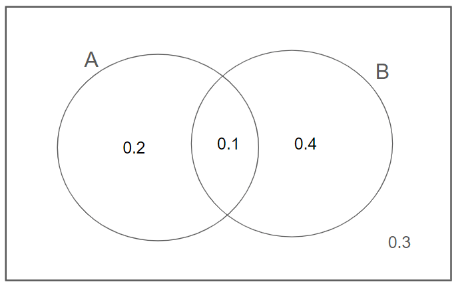 P(A) = 0.3, P(B) = 0.5, P(A ∩ B) = 0.1
P(A) = 0.3, P(B) = 0.5, P(A ∩ B) = 0.1
Let's try to observe every option one by one.
Option A : The two events 𝐴 and 𝐵 are independent
Two events are said to be Independent when : P(A ∩ B) = P(A).P(B)
P(A ∩ B) = 0.1
P(A).P(B) = 0.3 x 0.5 = 0.15
P(A ∩ B) ≠ P(A).P(B)
So, Option A is Incorrect.
Option B : P(A ∪ B) = 0.7.
P(A ∪ B) = P(A) + P(B) - P(A ∩ B)
= 0.3 + 0.5 - 0.1 = 0.7
So, Option B is Correct.
Option C : P(A ∩ Bc) = 0.2
P(A ∩ Bc) = P(A - B) = P(Only A) = 0.2
From Above Venn diagram it is clear that this is True.
So, Option C is Correct.
Option D : P(Ac ∩ Bc) = 0.4
P(Ac ∩ Bc) = P((A ∪ B)c) = 1 - P(A ∪ B)
From venn diagram it is clear that this value is 0.3 not 0.4.
This statement is False.
So, Option D is Incorrect.
Correct Answer : B, C.
Q4: Consider a permutation sampled uniformly at random from the set of all permutations of {1, 2, 3,⋯,n} for some n ≥ 4. Let X be the event that 1 occurs before 2 in the permutation, and Y the event that 3 occurs before 4 . Which one of the following statements is TRUE? (2024 SET-1)
(a) The events X and Y are mutually exclusive
(b) The events X and Y are independent
(c) Either event X or Y must occur
(d) Event X is more likely than event Y
Ans: (b)
Sol: Just by reading the question, it is evident that -
A. Events X and Y are not mutually exclusive, both events can occur simultaneously.
C. It is also possible that both even can not occur.
D. Both events are symmetric, their probabilities are exactly same.
B. Occurring of either event doesn't affect occurring of another event. Thus, independent.
P(X) = P(Y) = 0.5, P(X,Y) = 0.25 = P(x) * P(Y). This shows that indeed events X and Y are independent.
Total number of permutations = n!
Number of permutations where 1 comes before 2 = 
Number of permutations where 3 comes before 4 = 
Number of permutations where 1 comes before 2 and 3 comes before 4 = 
Answer - B.
Q5: Consider a random experiment where two fair coins are tossed. Let A be the event that denotes HEAD on both the throws, B be the event that denotes HEAD on the first throw, and C be the event that denotes HEAD on the second throw. Which of the following statements is/are TRUE? (2023)
(a) A and B are independent.
(b) A and C are independent.
(c) B and C are independent
(d) Prob(B|C) = Prob(B)
Ans: (c, d)
Sol: 2 Fair coins are tossed simultaneously. So, the sample space(S) is given by :
S = {HH, HT, TH, TT}.
Let, A be the event that denotes HEAD on both the throws.
Let, B be the event that denotes HEAD on the first throw.
Let, C be the event that denotes HEAD on the second throw.
For, Event A (Head on both coins), only one case is feasible which is HH.
∴ P(A) = 1 / 4
For, Event B (Head on first coins), only two cases are feasible which is HH, HT.
∴ P(B) = 1 / 2
For, Event C (Head on second coins), only one case is feasible which is HH, TH.
∴ P(C) = 1 / 2
NOTE : Two or more events are said to be independent, when the occurrence of one event does not affect the occurrence of other event.
In case of Independent Events : P(A ∩ B) = P(A) . P(B)
Let’s check options one by one :
Option – A) A & B are independent.
So, this will be true only when P(A ∩ B) = P(A) . P(B)
Here A ∩ B will have those cases having Head on first coin.
P(A ∩ B) = 1 / 2
P(A) = 1 / 4
P(B) = 1 / 2
P(A) . P(B) = 1 / 8
Clearly, P(A ∩ B) ≠ P(A) . P(B). So, Option A is FALSE.
Option – B) A & C are independent.
So, this will be true only when P(A ∩ C) = P(A) . P(C)
Here A ∩ C will have those cases having Head on second coin.
P(A ∩ C) = 1 / 2
P(A) = 1 / 4
P(C) = 1 / 2
P(A) . P(C) = 1 / 8
Clearly, P(A ∩ C) ≠ P(A) . P(C). So, Option B is FALSE.
Option – C) B & C are independent.
So, this will be true only when P(B ∩ C) = P(B) . P(C)
Here B ∩ C will have those cases having Head on both coin.
P(B ∩ C) = 1 / 4
P(B) = 1 / 2
P(C) = 1 / 2
P(B) . P(C) = 1 / 4
Clearly, P(B ∩ C) = P(A) . P(B). So, Option C is TRUE.
Option – D) P(B/C) = P(B)
P(B/C) = P(B ∩ C) / P(C)
P(B ∩ C) = 1 / 4 [See calculations in Option C]
P(C) = 1/2
P(B/C) = (1/4) / (1/2) = 2 / 4 = 1 / 2
P(B) = 1 / 2
Clearly, P(B/C) = P(B).
So, Option D is TRUE.
Finally, we have correct Options : C & D.
Q6: A bag has r red balls and bb black balls. All balls are identical except for their colours. In a trial, a ball is randomly drawn from the bag, its colour is noted and the ball is placed back into the bag along with another ball of the same colour. Note that the number of balls in the bag will increase by one, after the trial. A sequence of four such trials is conducted. Which one of the following choices gives the probability of drawing a red ball in the fourth trial? (2021 SET-2)
(a) 
(b) 
(c) 
(d) 
Ans: (a)
Sol: Assume that after ith iteration, we have r red balls and b black balls.
So, probability of choosing red ball in (i+1)th iteration will be :
=r/(r+b)
So, Probability of choosing red ball in (i+2)th iteration will be :
(note that, in (i+1)th iteration, we could either pick black or red ball.) So, in the beginning we have r red balls, and b green balls. So, in every iteration, the probability of choosing a red ball will be
So, in the beginning we have r red balls, and b green balls. So, in every iteration, the probability of choosing a red ball will be 
A beautiful question!! Whatever iteration we take, even in 100th iteration, probability of picking a red ball will be same.
Q7: In an examination, a student can choose the order in which two questions (QuesA and QuesB) must be attempted.
If the first question is answered wrong, the student gets zero marks.
If the first question is answered correctly and the second question is not answered correctly, the student gets the marks only for the first question.
If both the questions are answered correctly, the student gets the sum of the marks of the two questions.
The following table shows the probability of correctly answering a question and the marks of the question respectively.
Assuming that the student always wants to maximize her expected marks in the examination, in which order should she attempt the questions and what is the expected marks for that order (assume that the questions are independent)? (2021 SET-2)
(a) First QuesA and then QuesB. Expected marks 14.
(b) First QuesB and then QuesA. Expected marks 14.
(c) First QuesB and then QuesA. Expected marks 22.
(d) First QuesA and then QuesB. Expected marks 16.
Ans: (d)
Sol: First we answer A, then B:
- Expected marks = ProbabilityA is wrong ∗ 0 + ProbabilityA is correct ∗ ProbabilityB is wrong ∗ 10 + ProbabilityA is correct ∗ ProbabilityB is correct∗30
= 0.2 ∗ 0 + 0.8 ∗ 0.5 ∗ 10 + 0.8 ∗ 0.5 ∗ 30
= 0 + 4 + 12
= 16
First we answer B, then A:
- Expected marks = ProbabilityB is wrong ∗ 0 + ProbabilityB is correct ∗ ProbabilityA is wrong ∗ 20 + ProbabilityB is correct ∗ ProbabilityA is correct ∗ 30
= 0.5 ∗ 0 + 0.2 ∗ 0.5 ∗ 20 + 0.8 ∗ 0.5 ∗ 30
= 0 + 2 + 12
= 14
So to maximize marks we should first answer A and then B. The expected marks in such a scenarion will be 16.
Q8: For a given biased coin, the probability that the outcome of a toss is a head is 0.4. This coin is tossed 1,000 times. Let X denote the random variable whose value is the number of times that head appeared in these 1,000 tosses. The standard deviation of X (rounded to 2 decimal place) is ________ (2021 SET-2)
(a) 21.8
(b) 15.5
(c) 8.2
(d) 28.4
Ans: (b)
Sol: It is Independent trails with same rate of success. So we can use Binomial distribution
Probability of success (p) = 0.4
Probability of failure (q) = 1–0.4 = 0.6
Number of trials (n) = 1000
Variance = n × p × q = 1000 ∗ 0.4 ∗ 0.6 = 240
Standard deviation = √240 = 15.49
Q9: A sender (S) transmits a signal, which can be one of the two kinds: H and L with probabilities 0.1 and 0.9 respectively, to a receiver (R)
In the graph below, the weight of edge (u, v) is the probability of receiving v when u is transmitted, where u, v ∈ {H, L}. For example, the probability that the received signal is L given the transmitted signal was H, is 0.7.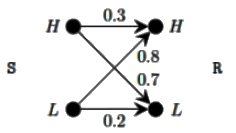 If the received signal is H, the probability that the transmitted signal was H (rounded to 2 decimal places) is __________. (2021 SET-1)
If the received signal is H, the probability that the transmitted signal was H (rounded to 2 decimal places) is __________. (2021 SET-1)
(a) 0.02
(b) 0.08
(c) 0.04
(d) 0.01
Ans: (c)
Sol: 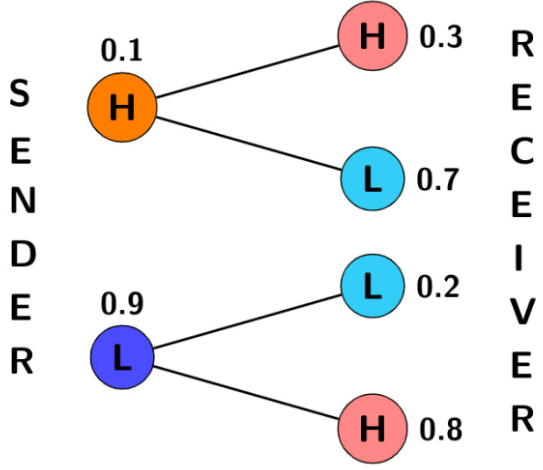
Given that:
P(Hs) = 0.1, P(Ls) = 0.9
From the diagram we get,
P(Hr∣Hs) = 0.3, P(Lr∣Hs) = 0.7,
P(Hr∣Ls) = 0.8,P(Lr∣Ls) = 0.2
We have to find: P(Hs∣Hr)
By Bayes theorem,
Probability of sending signal ‘H’ given that signal received is ‘H’,

Q10: The lifetime of a component of a certain type is a random variable whose probability density function is exponentially distributed with parameter 2. For a randomly picked component of this type, the probability that its lifetime exceeds the expected lifetime (rounded to 2 decimal places) is _________ (2021 SET-1)
(a) 0.37
(b) 0.87
(c) 0.58
(d) 0.22
Ans: (a)
Sol: For this question, we don’t even need the value of λ to get the answer.
It is good to remember this integration for solving questions on exponential distribution quickly. So, with this,
So, with this,
P(X ≤ a) = 1−e−λa,
P(X > a) = 1 – P(X ≤ a) = e−λa
P(a ≤ X ≤ b) = P(X ≤ b) – P(X ≤ a) = (1 − e−λb) – (1 − e−λa) = e−λa
So, for this question the answer will be  which will be
which will be 
Since the answer does not depend upon the value of λ, it means that it holds true for any exponential distribution.
Q11: For the distributions given below :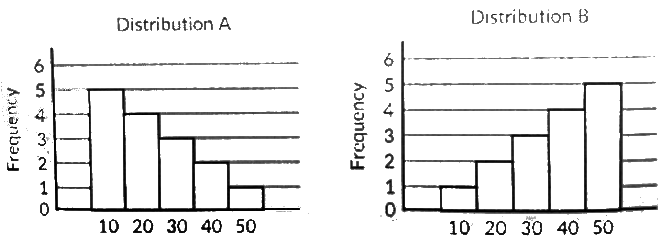 Which of the following is correct for the above distributions? (2020)
Which of the following is correct for the above distributions? (2020)
(a) Standard deviation of A is significantly lower than standard deviation of B
(b) Standard deviation of A is slightly lower than standard deviation of B
(c) Standard deviation of A is same as standard deviation of B
(d) Standard deviation of A is significantly higher than standard deviation of B
Ans: (c)
Sol: Standard deviation of A is the same as the standard deviation of B. This should be answered intuitively from the graph otherwise it would take too much time.
Q12: For n > 2, let a ∈ {0, 1}n be a non-zero vector. Suppose that x is chosen uniformly at random from {0, 1}n. Then, the probability that  is an odd number is______ (2020)
is an odd number is______ (2020)
(a) 0.25
(b) 0.5
(c) 0.75
(d) 0.9
Ans: (b)
Sol: Although a generalized answer is always good, we can also solve this question quickly by taking an example, say n = 3
Let a = (0, 0, 1). Then, for all 8 combinations of 'x' only 4 combinations (0, 0, 1), (0, 1, 1), (1, 0, 1), (1, 1, 1) will produce odd number (only 1 in this case), so probability will be 0.5.
Q13: Suppose Y is distributed uniformly in the open interval (1,6). The probability that the polynomial 3x2 + 6xY + 3Y + 6 has only real roots is (rounded off to 1 decimal place) _________. (2019)
(a) 0.25
(b) 0.5
(c) 0.8
(d) 0.9
Ans: (c)
Sol: Here, Y is uniformly distributed in (1, 6)
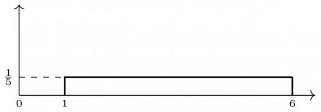
Now given Polynomial,
3x2 + 6xY + (3Y + 6)
For real roots b2 − 4ac ≥ 0
⇒ (6Y)2 − 4 × 3 × (3Y + 6) ≥ 0
⇒ Y2 − 2Y + Y−2≥0
⇒ (Y − 2)(Y + 1) ≥ 0
⇒ Y ≥ 2, Y ≥ −1
So, we need area of the region in the above graph, for (2, 6) Area = B x H
Area = B x H
= (6 - 2) x 1/5
= 4/5 = 0.8
Q14: Two numbers are chosen independently and uniformly at random from the set {1, 2, ..., 13}. The probability (rounded off to 3 decimal places) that their 4-bit (unsigned) binary representations have the same most significant bit is ______ (2019)
(a) 0.241
(b) 0.213
(c) 0.504
(d) 0.842
Ans: (c)
Sol: These are two groups:
- MSB with 1
- MSB with 0
nMSB0 = 7, nMSB1 = 6, ntotal = 13
Choose randomly and INDEPENDENTLY two elements out of 13 elements such that MSB is the same.

Q15: A class of 30 students occupy a classroom containing 5 rows of seats, with 8 seats in each row. If the students seat themselves at random, the probability that sixth seat in the fifth row will be empty is: (2018)
(a) 1/5
(b) 1/3
(c) 1/4
(d) 2/5
Ans: (c)
Sol: The class contains 5 rows of seats & each row having 8 seats ∴ The classroom have a total of (5 × 8) = 40 seats.
∴ The classroom have a total of (5 × 8) = 40 seats.
& the class has a total of 30 students.
Now, the 6th seat of row no. 5 has to be empty.
& We need to find the probability of the same.
We know, 
Now, the favorable ways will be when
30 students have the option to seat in 39 seats. (Because 6th seat of row no. 5 needs to be empty)
∴ Out of 39 seats 30 students can seat in 39C30 ways. [∵ As 30 students have to choose 30 seats out of 39 seats.]
And Total no. of ways will be when
30 students have the option to seat in 40 seats.
∴ No. of ways will be = 40C30 ways.
Now the probability of the 6th no. seat of row no. 5 will left vacant is = 
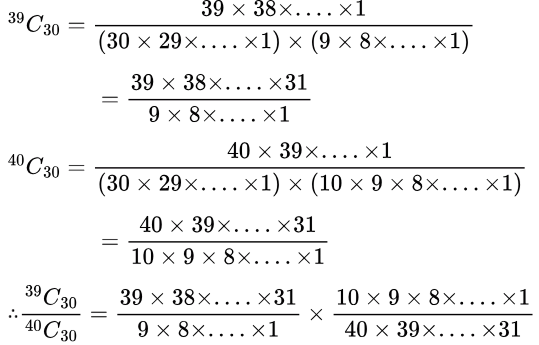 = 10/40 = 1/4
= 10/40 = 1/4
Q16: Consider Guwahati (G) and Delhi (D) whose temperatures can be classified as high (G), medium (M) and low (L). Let P(HG) denote the probability that Guwahati has high temperature. Similarly, P(MG) and P(LG) denotes the probability of Guwahati having medium and low temperatures respectively. Similarly, we use P(HD), P(MD) and P(LD) for Delhi.
The following table gives the conditional probabilities for Delhi's temperature given Guwahati's temperature.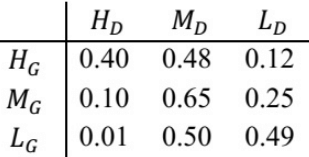 Consider the first row in the table above. The first entry denotes that if Guwahati has high temperature (HG) then the probability of Delhi also having a high temperature (HD) is 0.40; i.e., (HD|HG) = 0.40. Similarly, the next two entries are P(MD|HG) = 0.48 and P(LD|HG) = 0.12. Similarly for the other rows. If it is known that P(HG) = 0.2, P(MG) = 0.5, and P(LG) = 0.3, then the probability (correct to two decimal places) that Guwahati has high temperature given that Delhi has high temperature is _______ (2018)
Consider the first row in the table above. The first entry denotes that if Guwahati has high temperature (HG) then the probability of Delhi also having a high temperature (HD) is 0.40; i.e., (HD|HG) = 0.40. Similarly, the next two entries are P(MD|HG) = 0.48 and P(LD|HG) = 0.12. Similarly for the other rows. If it is known that P(HG) = 0.2, P(MG) = 0.5, and P(LG) = 0.3, then the probability (correct to two decimal places) that Guwahati has high temperature given that Delhi has high temperature is _______ (2018)
(a) 0.1
(b) 0.3
(c) 0.6
(d) 0.9
Ans: (c)
Sol:  P(HD) = P(HD|HG) + P(HG) + P(HD|MG).P(MG) + P(HD|LG).P(LG)
P(HD) = P(HD|HG) + P(HG) + P(HD|MG).P(MG) + P(HD|LG).P(LG)
= 0.4 x 0.2 + 0.1 x 0.5 + 0.01 x 0.3 = 0.133
∴ P(HG|HD) = 0.40 x 0.2 x (1/(P(HD)) = 0.08/0.133 = 0.6015
Q17: Two people, P and Q, decide to independently roll two identical dice, each with 6 faces, numbered 1 to 6. The person with the lower number wins. In case of a tie, they roll the dice repeatedly until there is no tie. Define a trial as a throw of the dice by P and Q. Assume that all 6 numbers on each dice are equi-probable and that all trials are independent. The probability (rounded to 3 decimal places) that one of them wins on the third trial is (2018)
(a) 0.022
(b) 0.22
(c) 1.22
(d) 0.066
Ans: (a)
Sol: One of them win in the third trial i.e. first two trial would be Tie and third should not be Tie.
Probability of Tie = 6/36 = 1/6
Probability of NO Tie = 1 - (1/6) = 5/6
Winning in the third Tie = (First Tie) * (Second Tie) * (No Tie) = 
Q18: Let A and B be any two arbitrary events, then, which one of the following is TRUE? (2017)
(a) P(A ∩ B) = P(A)P(B)
(b) P(A ∪ B) = P(A) + P(B)
(c) P(A∣B) = P(A ∩ B)P(B)
(d) P(A ∪ B) ≤ P(A) + P(B)
Ans: (d)
Sol:
- Is true only if events are independent.
- Is true only if events are mutually exclusive i.e. P(A ∩ B) = 0
- Is false everywhere.
- Is always true as P(A ∪ B) = P(A )+ P(B) − P(A ∩ B)
Since, P(A ∩ B)> = 0, P(A ∪ B) ≤ P(A) + P(B)
Correct Answer: D.
Q19: For any discrete random variable X, with probability mass function
P(X = j) = pj,pj ≥ 0, j ∈ {0,....N} and  define the polynomial function gx(z) =
define the polynomial function gx(z) =  For a certain discrete random variable Y, there exists a scalar β ∈ [0, 1] such that gY(z) = (1 − β + βz)N. The expectation of Y is (2017 SET-2)
For a certain discrete random variable Y, there exists a scalar β ∈ [0, 1] such that gY(z) = (1 − β + βz)N. The expectation of Y is (2017 SET-2)
(a) N β (1 − β)
(b) Nβ
(c) N(1 − β)
(d) Not expressible in terms of N and β alone
Ans: (b)
Sol: Notice that the derivative of gx(z) evaluated at z = 1 gives expectation E(X)
Therefore, take derivative of gy(z) with respect to z, and plug in z = 1

So, Answer is option (B).
Q20: P and Q are considering to apply for a job. The probability that P applies for the job is 1/4. The probability that P applies for the job given that Q applies for the job is 1/2 , and the probability that Q applies for the job given that P applies for the job 1/3. Then the probability that P does not apply for the job given that Q does not apply for the job is (2017 SET-2)
(a) 4/5
(b) 5/6
(c) 7/8
(d) 11/12
Ans: (a)
Sol: Let,
P = P applies for the job
Q = Q applies for the job Now, we need to find P(P'|Q')
Now, we need to find P(P'|Q')
From (2) From (1) and (3),
From (1) and (3), From (4) and (5),
From (4) and (5), From (6)
From (6)
P(Q′) = 1 − (1/6) = 5/6→(8)
Also, P(P′ ∩ Q′) = 1 − [P(P ∪ Q)]
= 1 − [P(P) + P(Q) − P(P ∩ Q)]
= 1 − [1/4 + 1/6 − 1/12]
= 1 − [1/3]
= 2/3 → (9)
Hence, from (7), (8) and (9) Correct Answer: A.
Correct Answer: A.
Q21: Let X be a Gaussian random variable mean 0 and variance σ2 . Let Y = max(X, 0) where max (a, b) is the maximum of a and b. The median of Y is ____________. (2017 SET-1)
(a) 0
(b) 1
(c) ∞
(d) - ∞
Ans: (a)
Sol: Variable Y can take only non-negative values. Median of a distribution is a value c such that
P(0 < Y < c) = P(c < Y < ∞)
Now for L.H.S., Y will lie between 0 and c only when X < c i.e P(0 < Y < c) = P(X < c).
For R.H.S, Y > c only when X > c i.e. P(c < Y < ∞) = P(X > c) = 1 − P(X < c)
Equating both sides, we get P(X < c) = 1 − P(X < c) ⇒ P(X < c) = 0.5 ⇒ c = 0.
Hence 0 is the answer.
Q22: Suppose that a shop has an equal number of LED bulbs of two different types. The probability of an LED bulb lasting more than 100 hours given that it is of Type 1 is 0.7, and given that it is of Type 2 is 0.4. The probability that an LED bulb chosen uniformly at random lasts more than 100 hours is _________. (2016 SET-2)
(a) 0.25
(b) 0.55
(c) 0.65
(d) 0.75
Ans: (b)
Sol: Given that the shop has an equal number of LED bulbs of two different types. Therefore,
Probability of Taking Type 1 Bulb = 0.5
Probability of Taking Type 2 Bulb = 0.5
The probability of an LED bulb lasting more than 100 hours given that it is of Type 1 is 0.7, and given that it is of Type 2 is 0.4. i.e.,
Prob(100 + ∣Type1) = 0.7
Prob(100 + ∣Type2) = 0.4
Prob(100+) = Prob(100+ ∣ Type1) × Prob(Type1) + Prob(100+ ∣ Type2) × Prob(Type2)
= 0.7 × 0.5 + 0.4 × 0.5 = 0.55.
Q23: Consider the following experiment.
Step 1. Flip a fair coin twice.
Step 2. If the outcomes are(TAILS, HEADS) then output Y and stop.
Step 3. If the outcomes are either(HEADS, HEADS) or(HEADS, TAILS), then output N and stop.
Step 4. If the out comes are(TAILS, TAILS), then go to Step1.
The probability that the output of the experiment is Y is (up to two decimal places)_____. (2016 SET-1)
(a) 0.25
(b) 0.33
(c) 0.5
(d) 0.75
Ans: (b)
Sol: Answer is 0.33
1st time it is 0.25(1/4), when tail tail comes, entire process gets repeated, so next time probability of Y to happen is  likewise it goes on as infinite GP
likewise it goes on as infinite GP
Sum of infinite GP 
here, a = 1/4 and r = 1/4
so answer becomes 1/3 i.e 0.33
Q24: A probability density function on the interval [a, 1] is given by 1/x2 and outside this interval the value of the function is zero.The value of a is __________. (2016 SET-1)
(a) 0.25
(b) 0.5
(c) 0.75
(d) 1
Ans: (b)
Sol: We know that the sum of all the probabilities is 1
Therefore, on integrating 1/(x2) with limits a to 1, the result should be 1.
Hence, 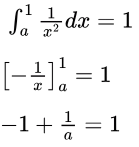 Hence, a = 0.5
Hence, a = 0.5
Q25: Suppose Xi for i = 1, 2, 3 are independent and identically distributed random variables whose probability mass functions are Pr[Xi = 0] = Pr [Xi = 1] = 1/2 for i = 1, 2, 3. Define another random variable Y = X1 X2 ⊕ X3, where ⊕ denotes XOR. Then
Pr[Y = 0∣X3 = 0] = __________. (2015 SET-3)
(a) 0.25
(b) 0.5
(c) 0.75
(d) 1
Ans: (c)
Sol: As X3 = 0 is given, to have Y = 0, X1X2 should be 0, meaning (X1, X2) should be one of {(0, 0) (0, 1) (1, 0)}
So, required probability 
∵ we can choose any of the 3 possibilities in 3 ways and then probability of each set of two combination is 
We can also do like follows:
There are totally 4 possibilities - {(0, 0) (0, 1) (1, 0), (1, 1)}, out of which 3 are favourable cases.
So, required probability = 3/4 = 0.75.
Q26: The probability that two friends are born in the same month is ____ ? (2014)
(a) 1/6
(b) 1/12
(c) 1/144
(d) 1/24
Ans: (b)
Sol: Let us say that what is the probability that they are not born in same month?
A can be born in any of 12 months and B can be born in any of the remaining 11 months ⇒ Total possible cases = 12 x 11 = 132
Total Sample space with us : 12 x 12 = 144
⇒ The probability that they are not born in same month = 132/144
⇒ The probability that they are born in the same month 
Alternatively,
Let the first friend be born in any of the 12 months. For the second friend we have 12 cases and only 1 is favorable. So, probability = 
Q27: Let S be a sample space and two mutually exclusive events A and B be such that A ∪ B = S. If P(.) denotes the probability of the event, the maximum value of P(A)P(B) is ______ (2014 SET-3)
(a) 0.25
(b) 0.5
(c) 0.75
(d) 1
Ans: (a)
Sol:  P(A) + P(B) = 1, since both are mutually exclusive and A ∪ B = S.
P(A) + P(B) = 1, since both are mutually exclusive and A ∪ B = S.
When sum is a constant, product of two numbers becomes maximum when they are equal.
So, P(A) = P(B) = 1/2.
Q28: The probability that a given positive integer lying between 1 and 100 (both inclusive) is NOT divisible by 2, 3 or 5 is ______ . (2014 SET-2)
(a) 0.12
(b) 0.56
(c) 0.26
(d) 0.42
Ans: (c)
Sol: Number of integers divisible by 2 = 50
Number of integers divisible by 3 = 33
Number of integers divisible by 5 = 20
Number of integers divisible by 2 and 3 = 16
Number of integers divisible by 2 and 5 = 10
Number of integers divisible by 3 and 5 = 6
Number of integers divisible by 2 and 3 and 5 = 3
Total numbers divisible by 2 or 3 or 5 = 50 + 33 + 20 − 16 − 10 − 6 + 3 = 74
Total number not divisible by 2 or 3 or 5 = 26
Probability = 0.26 [EDIT]
Q29: Each of the nine words in the sentence "The quick brown fox jumps over the lazy og" is written on a separate piece of paper. These nine pieces of paper are kept in a box. One of the pieces is drawn at random from the box. The expected length of the word drawn is _____________. (The answer should be rounded to one decimal place) (2014 SET-2)
(a) 2.5
(b) 2.9
(c) 3.8
(d) 4.6
Ans: (c)
Sol: Each of the nine words have equal probability. So, expected length

= 35/9
= 3.9
Q30: The security system at an IT office is composed of 10 computers of which exactly four are working. To check whether the system is functional, the officials inspect four of the computers picked at random (without replacement). The system is deemed functional if at least three of the four computers inspected are working. Let the probability that the system is deemed functional be denoted by p. Then 100p = _______. (2014 SET-2)
(a) 9.2
(b) 11.9
(c) 15.6
(d) 19.2
Ans: (b)
Sol: Initially P (working computer) = 4/10, P(non-working computer) = 6/10.
Case 1 : three computers are functional : There are 4 sub-cases WWWN, WWNW, WNWW, NWWW, where W means working, N means non-working, but P(WWWN) = P(WWNW) = P(WNWW) = P(NWWW), because for example
In all other 3 sub-cases, we get same numerators and denominators (in different order), so total prob in this case is Case 2 : all 4 are working
Case 2 : all 4 are working P (atleast 3 are working) = 600/5040
P (atleast 3 are working) = 600/5040
So 100 x P = 11.90.
Q31: For fair six-sided dice are rolled. The probability that the sum of the results being 22 is X/1296. The value of X is _________ (2014 SET-1)
(a) 4
(b) 6
(c) 10
(d) 24
Ans: (c)
Sol:
There are only two possible sets whose elements sum to 22 : {6, 6, 6, 4}, {6, 6, 5, 5}
Number of permutations for 1st set: 4!/3! = 4
Number of permutations for 2nd set : 
So total number of ways to sum 22 =10
So X = 10.
Q32: Suppose you break a stick of unit length at a point chosen uniformly at random. Then the expected length of the shorter stick is (2014 SET-1)
(a) 0.25
(b) 0.5
(c) 0.75
(d) 1
Ans: (a)
Sol: The length of the shorter stick can be from 0 to 0.5 (because if it is greater than 0.5, it is no longer a shorter stick).
This random variable L (length of shorter stick) follows a uniform distribution, and hence probability density function of L is 1/(0.5−0) = 2 for all lengths in range 0 to 0.5
Now expected value of 
Q33: Let P(E) denote the probability of the occurrence of event E. If P(A)= 0.5 and P(B)=1 then the values of P(A|B) and P(B|A) respectively are (2013)
(a) 0.5, 0.25
(b) 0.25, 0.5
(c) 0.5, 1
(d) 1, 0.5
Ans: (c)
Sol: P(A)= 0.5
P(B) = 1
Here there is no dependency in event A and B.
So P(A ∩ B) = P(A) * P(B)
P(A/B) = probability of occurrence of event A when B has already occurred
= P(A ∩ B) / P(B)
= (0.5 * 1) /1 = 0.5
P(B/A)= probability of occurrence of event B when A has already occurred
= P(B ∩ A) / P(A)
= (1 * 0.5) / 0.5 = 1
Ans- C
Q34: Suppose p is the number of cars per minute passing through a certain road junction between 5 PM and 6 PM, and p has a Poisson distribution with mean 3. What is the probability of observing fewer than 3 cars during any given minute in this interval? (2013)
(a) 8/(2e3)
(b) 9/(2e3)
(c) 17/(2e3)
(d) 26/(2e3)
Ans: (c)
Sol:
Poisson Probability Mass Function (with mean λ) = 
We have to sum the probability mass function for k = 0, 1 and 2 and λ = 3(thus finding the cumulative mass function)

Q35: Suppose a fair six-sided die is rolled once. If the value on the die is 1, 2, or 3, the die is rolled a second time. What is the probability that the sum total of values that turn up is at least 6? (2012)
(a) 10/20
(b) 5/12
(c) 2/3
(d) 1/6
Ans: (b)
Sol: Here our sample space consists of 3 + 3 × 6 = 21 events- (4), (5), (6), (1, 1), (1, 2) … (3, 6).
Favorable cases = (6), (1, 5), (1, 6), (2, 4), (2, 5), (2, 6), (3, 3), (3, 4), (3, 5), (3, 6).
Required Probability =
But this is wrong way of doing. Because due to 2 tosses for some and 1 for some, individual probabilities are not the same. i.e., while (6) has 1/6 probability of occurrence, (1, 5) has only 1/36 probability. So, our required probability Correct Answer: B
Correct Answer: B
Q36: Consider a random variable X that takes values +1 and -1 with probability 0.5 each. The values of the cumulative distribution function F(x) at x = -1 and +1 are (2012)
(a) 0 and 0.5
(b) 0 and 1
(c) 0.5 and 1
(d) 0.25 and 0.75
Ans: (c)
Sol: Given P(−1) = 0.5 and P(1) = 0.5. So, at all other points P must be zero as the sum of all probabilities must be 1.
So,F(−1) = 0.5 and
F(1) = P(−1) + 0 + 0 +...+ P(1)
= 0.5 + 0.5 = 1
Correct Answer: C.
Q37: Three coins are tossed simultaneously. The probability that they will fall two heads and one tail is (2011)
(a) 5/8
(b) 1/8
(c) 2/3
(d) 3/8
Ans: (d)
Sol: In 3 coins we are getting 2 heads and 1 tail (H,H,T), (H,T,H), (H,H,T) = 3! / 2! = 3 ways
Now, probability = 3/23 =3/8
Q38: A deck of 5 cards (each carrying a distinct number from 1 to 5) is shuffled thoroughly. Two cards are then removed one at a time from the deck. What is the probability that the two cards are selected with the number on the first card being one higher than the number on the second card? (2011)
(a) 1/5
(b) 4/25
(c) 1/45
(d) 2/5
Ans: (a)
Sol: The number on the first card needs to be One higher than that on the second card, so possibilities are :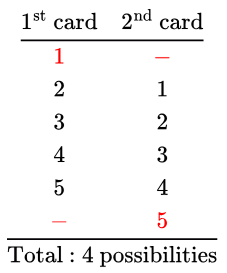 Total possible ways of picking up the cards = 5 × 4 = 20
Total possible ways of picking up the cards = 5 × 4 = 20
Thus, the required Probability 
Option A is correct.
Q39: Consider a finite sequence of random values X = [x1, x2,..., xn]. Let μx be the mean and σx be the standard deviation of X .Let another finite sequence Y of equal length be derived from this as yi = a ∗ xi + b, where a and b are positive constants. Let Let μy be the mean and σy be the standard deviation of this sequence. Which one of the following statements is INCORRECT? (2011)
(a) Index position of mode of X in X is the same as the index position of mode of Y in Y.
(b) Index position of median of X in X is the same as the index position of median of Y in Y.
(c) μy = aμx + b
(d) σy = aσx + b
Ans: (d)
Sol: Mean, median and mode are linear functions over a random vaiable.
So, multiplying by constants or adding constants wont change their relative position.
Standard deviation is not a linear function over a random variable.
Q40: If the difference between the expectation of the square of random variable (E[X2]) and the square of the expectation of the random variable (E[X2]) is denoted by R then (2011)
(a) R = 0
(b) R < 0
(c) 
(d) R > 0
Ans: (c)
Sol: The difference between (E[X2]) and (E[X])2 is called variance of a random variable. Variance measures how far a set of numbers is spread out. (A variance of zero indicates that all the values are identical.) A non-zero variance is always positive.
Q41: If two fair coins are flipped and at least one of the outcomes is known to be a head, what is the probability that both outcomes are heads? (2011)
(a) 1/3
(b) 1/4
(c) 1/2
(d) 2/3
Ans: (a)
Sol: Probability of at least one head, P1H = 3/4
Probability of both heads, P2H = 1/4
Using Bayes' theorem, 
Q42: What is the probability that divisor of 1099 is a multiple of 1096? (2010)
(a) 1/625
(b) 4/625
(c) 12/625
(d) 16/625
Ans: (a)
Sol: Prime factorization of 10 = 2 × 5.
So, 1099 = 299 × 599 and
No. of possible factors for 1099 = No. of ways in which prime factors can be combined
= 100 × 100 (1 extra possibility for each prime number as prime factor raised to 0 is also possible for a factor)
1099 = 1096×1000
So, no. of multiples of 1096 which divides 1099 = No. of possible factors of 1000
= 4 × 4(∵ 1000 = 23 × 53) (See below)
= 16
So, required probability = 16/10000
= 1/625
Correct Answer: A
How is number of possible factors of 1000 = 16?
Here, we can prime factorize 1000 as 23 × 53. Now, any factor of 1000 will be some combination of these prime factors. For 2, a factor has 4 options - 20, 21, 22 or 23. Similarly 4 options for 5 also. This is true for any number n, if n can be prime factorized as  , number of factors of n = (m1+1) × (m2+1) ×⋯× (mn+1), the extra one in each factor term coming for power being 0.
, number of factors of n = (m1+1) × (m2+1) ×⋯× (mn+1), the extra one in each factor term coming for power being 0.
Q43: Consider a company that assembles computers. The probability of a faulty assembly of any computer is p. The company therefore subjects each computer to a testing process. This testing process gives the correct result for any computer with a probability of q. What is the probability of a computer being declared faulty? (2010)
(a) pq + (1 - p) (1 - q)
(b) (1 - q)p
(c) (1 - p) q
(d) pq
Ans: (a)
Sol: In image below the ticks show those branches where the result is declared as faulty.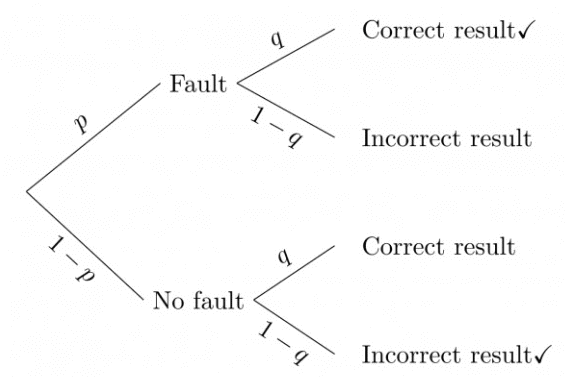 So, required probability = sum of probabilities of those two branches = pq + (1-p)(1-q).
So, required probability = sum of probabilities of those two branches = pq + (1-p)(1-q).
|
34 videos|123 docs|72 tests
|
FAQs on Previous Year Questions: Probability Theory - Engineering Mathematics for Computer Science Engineering - Computer Science Engineering (CSE)
| 1. What is the basic concept of probability theory in computer science engineering? |  |
| 2. How is probability theory applied in computer science engineering? |  |
| 3. What are some common probability distributions used in computer science engineering? |  |
| 4. How does probability theory help in designing algorithms in computer science engineering? |  |
| 5. Can probability theory be used to analyze the reliability of computer systems in engineering? |  |
|
34 videos|123 docs|72 tests
|

|
Explore Courses for Computer Science Engineering (CSE) exam
|

|














